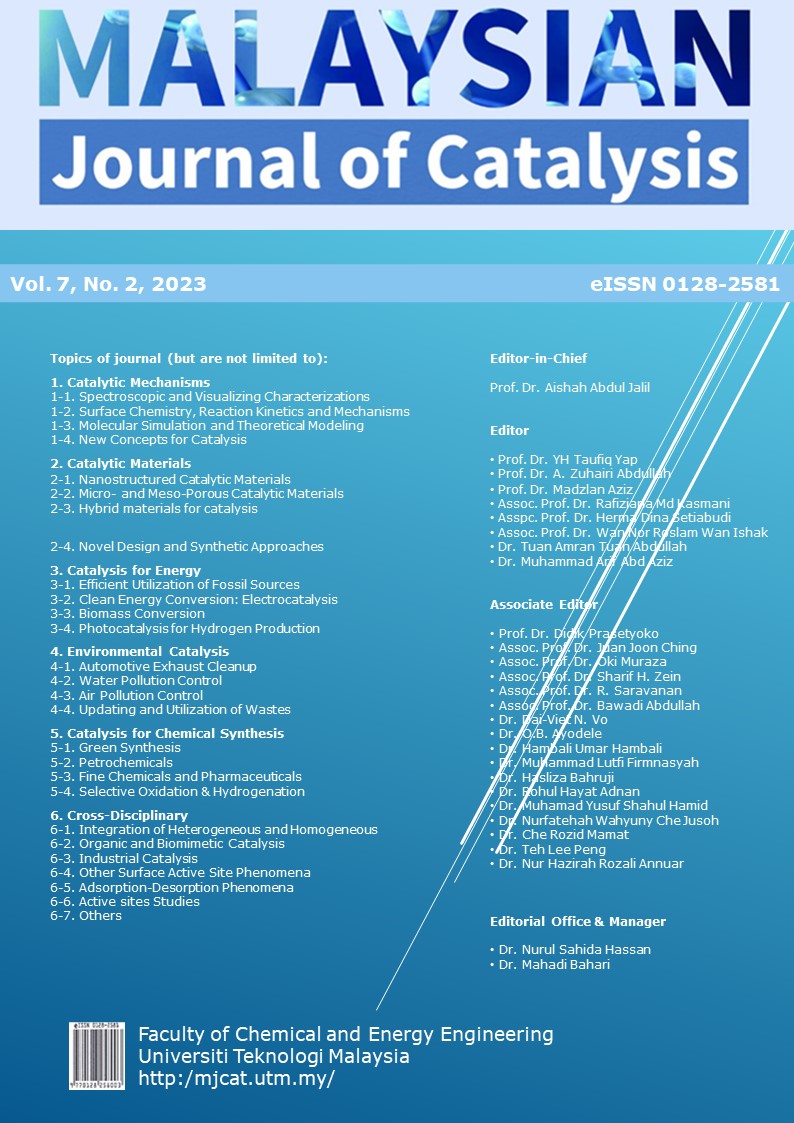Effect of Transition Metal/Graphitic Carbon Nitride for Photoreduction of Hexavalent Chromium
DOI:
https://doi.org/10.11113/mjcat.v7n2.176Abstract
Recently, the discharge of heavy metals such as hexavalent chromium (Cr(VI)) into water is increasing due to the development of industrials. This poses a huge environmental challenges as toxic waste of heavy metal leads to water pollution which give a negative impact on health and environment. This heavy metal can be treated by reducing the highly poisonous of Cr(VI) to less toxic trivalent chromium Cr(III). Nowadays, the photocatalytic reduction is one of the effective method that can reduce Cr(VI) to harmless toxic into the environment. In this study, the effect of different metal of Ag, Cu and Ni loaded on g-C3N4 were investigated based on the structural, morphological, compositional, and optical properties. The different metal of Ag, Cu and Ni were loaded on g-C3N4 by using impregnation method. The physical and chemical properties of Ag, Cu and Ni loaded on g-C3N4 were analyzed using FTIR and UV-vis/DRS techniques. The performance of photocatalytic activity among Ag, Cu and Ni loaded on g-C3N4 were evaluated for photoreduction of Cr(VI) and the highest performance of photoreduction of Cr(VI) was demonstrated by Ag/C3N4 (87%), followed by Cu/C3N4 (85%), Ni/C3N4 (80%) and pure g-C3N4 (77%) under visible-light. Among of photocatalyst, Ag/C3N4 was revealed as the best performance in photoreduction of Cr(VI) owing to its change in morphology, strong interaction between Ag and C N bonds and low band gap. Besides, the effect of scavengers shows the active species was the photogenerated electron (e-) play an important role on photoreduction of Cr(VI). Overall, the Ag loaded on g-C3N4 was successfully contribute on photoreduction of Cr (VI) under visible light.

Downloads
Published
How to Cite
Issue
Section
License

This work is licensed under a Creative Commons Attribution-NonCommercial 4.0 International License.
The Malaysian Journal of Catalysis publishes open access articles under the terms of the Creative Commons Attribution (CC BY) License which permits use, distribution and reproduction in any medium, provided the original work is properly cited.Â
The Department of Chemistry, Faculty of Science, UTM retains the Copyright on any research article published by Malaysian Journal of Catalysis.
Authors grant Malaysian Journal of Catalysis a license to publish the article and identify itself as the original publisher.















